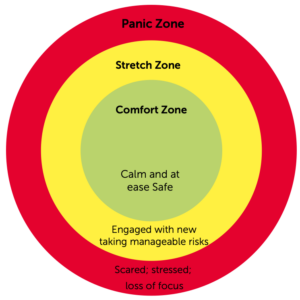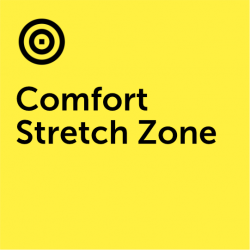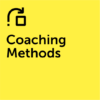BACKGROUND
The model developed by Karl Rohnke states that performance can only be achieved under modest pressure. Too little pressure or too much is not conducive to an increase in performance. In order to develop yourself further – whether professionally or personally – you have to know your limits and learn how to change them. The limits are different for everyone and everyone can go little steps in order to stretch those limits.
There are three zones in the model developed by Karl Rohnke: Comfort, stretch and panic zone.

Comfort Zone:
Your Comfort Zone is just that – comfortable – and includes everyday activities such as doing the same things and mixing with the same people. When most of your activities are located in this zone life feel ‘comfortable’ of course. But, you do not learn very much in this zone nor are you able to develop yourself.
- Engaged in familiar activities
- Calm and at ease
- Complacent
- Comfortable
- Safe
- Gathering your strength
- Recovering
- Filling your cup
- Low Anxiety
- Boredom
Stretch, Challenge or Learning Zone
Your Learning or Stretch Zone is the area of novelty, exploration and adventure. Here are the things that are a little or a lot out of the ordinary – the things you haven’t done for a long time or have never done before. This zone is not really a comfortable place – but it is a stimulating one. It is where we stretch and challenge ourselves mentally, emotionally or physically. You need to be in the stretch zone to learn and grow. But you can’t remain in the stretch zone all the time or you’ll burn out.
These are some of the qualities you’ll experience in the stretch zone:
- Engaging with the new or unknown
- Taking manageable risks
- Challenging yourself but not too much
- Excited, energized, engaged, motivated but not overwhelmed
- Learning, growth, and success
Panic Zone
The Panic Zone is the area of things-to-be- avoided either because they are unacceptable to you or because they are currently a ‘stretch’ too far! The boundaries between the different zones are blurry. For one person speaking in public at work would already be in the panic zone, while thinking about extreme sports during holiday is not. You may have activities in the Panic Zone . which you wish to do easily but which feel too frightening for you at the moment. It’s difficult to learn or grow in the panic zone because most of your energy is used trying to reduce stress and anxiety. This is why performance declines with too much pressure.
These are some of the qualities you’ll experience in the panic zone
- Scared
- Distressed
- Overwhelmed
- Alert mode
- Flight or flight reactions: you runaway, fight or freeze
- Overwhelmed
- Stressed
- Fearful
- Anxious
- Loss of focus
- Frantic
STEP-BY-STEP INSTRUCTIONS
During the exercise, each participant should develop a feeling for what it feels like to be in the respective zones. Each participant can individually develop a feeling for his/her limits. With the following reflection questions s/he can become aware of his/her limits once more. In the plenum exchange the group is to recognize that each participant has different borders.
Preparation:
Prepare the diagram (see above) on a physical or remote whiteboard. Prepare cards with the three activities (singing, dancing, painting). Each participant should get one of each options. Prepare the reflection questions on a flip chart.
Instructions:
- The facilitators pose a question which is relevant to the audience: for example “How do I explain to a colleague who hasn’t heard anything about this project what it is all about?
- They give three different options of how to answer this question:
- Singing or Rapping
- Pantomime or dancing
- Painting or drawing cartoon
- The facilitators give a small demo for each of the options.
- The participants feel which of the three activities belongs to which zone for them.
- They place cards in the circles on the diagram according to where each activity is located from their perspective.
- You set up groups of three.
- Everyone picks one activity which they have placed in their personal stretch zone to answer the question in max. 1 min.
- The participants listen to their inner voice, their feelings and emotions for 20 sec. Everyone answers the reflection questions for themselves (silently).
- Afterwards the entire group exchanges in the plenum.
Reflection question
- What inner voices did you perceive when you had to go out of your comfort zone into the stretch zone?
- What did you feel in your body?
- Was there a moment when you said to yourself: “I’m not doing that”?
- What was it like when you overcame your fear?
- What feeling did you experience?
- If you now look at your everyday life, what do you think how much time do you spend in which zone – approximately in % sentences?
- What would it mean for you if you actively changed your division of zones?
SOURCE
The exercise was developed by mermaid & broccoli GmbH based on the work of Karl Rohnke and the Yerke/Dodson law.




